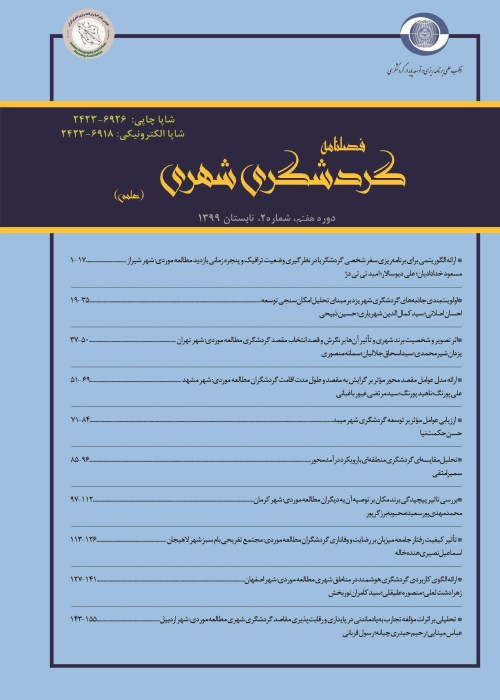Analysis of Urban Branding Potential and Brand Elements of Tourism Destinations based on Identity-Based Approach
The concept of urban branding in the field of tourism is discussed when large- scale recreational destinations and projects compete at the international level in order to attract more tourists and large investments as well as to foster economic and urban development. This concept enables the creation of an effective image and perception in the mind of tourists towards unique and distinctive features of each destination. Such a distinction is made through branding so as to encourage tourists to pay more in that region and increase the standard of urban life. On the other hand, identity and culture of a city; as an integral part of the destination, are the key element of branding that can improve created mental image by tourists. The presence of these complex factors in the brand structure of a destination demands need the existence of elements that convey the brand 's message completely and clearly to tourists and brings positive feedback and satisfaction from the experience of the destination tourism product. Among different cities and regions of Iran, Yazd is considered as an ancient urban civilization that has been inscribed to the UNESCO world organization. However, it has failed to acknowledge itself as a successful urban brand in the country and the world and also there were implemented only some progress to distinctive branding activities.
The aim of this study is to examine the branding potential of Yazd city by emphasizing on an identity - based approach and other effective components on urban tourism such as culture and destination image and the impact of urban tourism components on symbolic elements of brand and finally the effect of brand elements on city branding. The present study is applied in terms of purpose and descriptive- correlational in terms of data collection. The statistical population of the study consisted of all domestic tourists who visited Yazd city during the fall in 2019. A total of 265 (137 male & 128 female) individuals were selected by non- probability sampling method of convenience sampling. All the tourists completed questionnaires of urban tourism and brand elements. After calculating the validity and reliability of the tools, the data were analyzed using mean descriptive indexes, standard deviation and Pearson correlation coefficient. In addition, structural equation modeling and multiple regression model were used to validate the hypothesized relationship.
In order to answer the research questions and investigate the relationship structure of variables in the model and the degree of power of foresight of independent variables (culture, destination identity and destination image) on the dependent variables (symbol, slogan, and branding), the statistical method of path analysis using multiple regression was used in sequential method based on the analysis of Baron and Kenny with SPSS software. To check the existing paths in the model, the following steps were implemented: 1- regression of culture, identity and destination image on symbol 2- regression of culture, identity and destination image on the slogan 3- regression of culture, identity and destination image on branding. The results showed that destination culture and image are significant predictors of each brand elements (including symbol, slogan and branding), but the destination identity (with negative regression coefficient) was not considered as a significant predictor of any brand elements. The results show that the final model has a relatively appropriate fit with the data. Moreover, in the final model, urban tourism elements had a direct and significant effect on brand elements.
As the findings show, the destination culture and image have a significant and direct impact on brand elements; but identity does not have a significant effect on brand elements. However, this study does not deny the effects of the identity variable on the destination brand and the reason for this non - significant and the negative regression coefficient with brand elements is the low scores offered by internal tourists to the identity elements of Yazd. Therefore, based on these results, it can be said that only consideration of a dominant approach such as the identity-based one from the perspective of tourists for positioning urban branding cannot be considered alone; but this process, integrated and strategic management, comprehensive short - term tourism, development plan, holding urban start – ups, the identification and promotion of the city 's identity and image with the use of symbol, slogan, textile, souvenir and handicrafts, the political alliance and the participation of public and private enterprises of tourism and souvenir and finally demand global advertising and sustainable local development to serve as a successful urban brand in Iran and the world.
- حق عضویت دریافتی صرف حمایت از نشریات عضو و نگهداری، تکمیل و توسعه مگیران میشود.
- پرداخت حق اشتراک و دانلود مقالات اجازه بازنشر آن در سایر رسانههای چاپی و دیجیتال را به کاربر نمیدهد.



